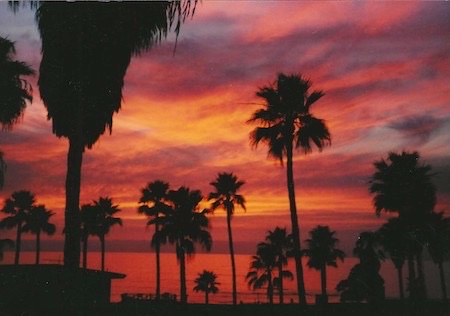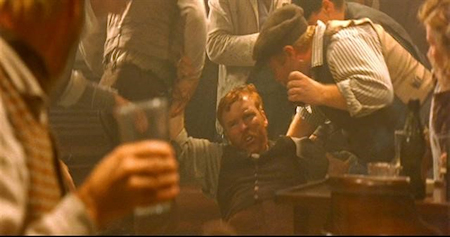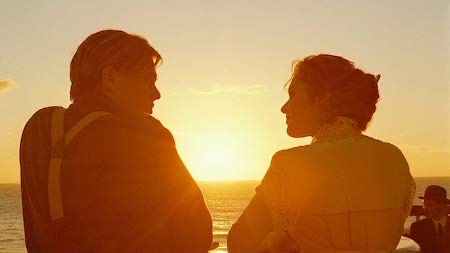 |  |
By Greg Niemann

When “Titanic” Director James Cameron accepted the Motion Picture Academy’s Oscar for Best Picture of the Year in 1998 he threw out his arms and proudly said, “I’m King of the World.”
A lot of people in Baja shared his excitement. After all, “Titanic,” the former top-grossing movie of all time, was filmed in Baja at a place called Popotla, just south of Rosarito Beach.
“Titanic” began filming even before the new 20th Century Fox studio was completed. Little did we on the Gold Coast realize that the new studio’s first movie was to become an instant classic.
Before June 1, 1996, the 33-acre Fox site was a wind-blown dusty plateau sandwiched between the Old Road (Libre) and the pounding ocean cliffs, adjacent to the Popotla arch, just a few miles south of Rosarito Beach.
Like an army of ants, workers from both sides of the border were abuzz with activity on this Baja bluff, pouring tons of concrete, framing buildings and stages, painting sets and beginning the construction of a detailed life-size replica of the historic ship Titanic.
The Titanic, renowned for its ill-fated maiden voyage from Southampton, England to New York in 1912, cost $10 million to build at the time. The movie “Titanic” cost over 20 times that, over $200 million, making it the then most expensive movie ever made.
Twentieth Century Fox originally planned to build the studio for the one production, but once underway, decided to construct a studio that will long endure.
World search ends in Baja
The Baja site was not selected lightly. The search literally took them all over the world. When they saw Popotla, officials said, they stopped looking. Fox Film Entertainment Chief Financial Officer Simon Bax said, “It had everything we needed. And the great thing is, it’s so close to California. It’s an easy drive from Los Angeles.”
Filming on the movie started on Sept. 16, 1996, using finished parts of the studio while the remainder was still being constructed.

Fox sent down its top facility executive, Fernando Carrillo, Director of Studio Operations, to get the studio job done while keeping the production team on schedule. No stranger to Baja, he and his wife Lilia had owned a vacation home at nearby La Paloma for nine years previously.
“It would have been ideal to have the studio completed before Production took over,” said Carrillo, “but we’re making the best of it and we’re staying ahead of them.”
The studio had contracted out about 700 workers, most of them Mexican citizens, to build the tanks and pumps and roads and buildings. More than half were bussed in from Rosarito, Ensenada and Tijuana.
According to contractor Howard Hargrove, the benefits of building the studio and making the movie in Mexico are great. “If this was being done in the States, it would cost five times more and take 10 times longer. At this point, we’d probably still be getting permits in the States,” he said.
Production had about 500 people building, preparing, and painting sets, producing scenic art, filming, and making sure the “Titanic” got finished.
Two visits during production
Everything I saw on my two escorted visits during filming impressed me. The Titanic was in pieces, all over the lot. We walked past fiberglass anchors and smokestacks. Pulleys, vents and portholes were all being constructed for their eventual day of glory in front of the cameras.
Large booms rose into the sky, assembling stages and buildings and the ship itself.
In Stage 4 shooting was going on. Extras in wetsuits covered with life jackets bobbed in a pool-size tank amid debris and crates and began moaning or playing dead once the cameras started rolling. Behind the cameras hot coffee rested on a floating table.
Workshops, paint shops, set design shops, carpenter shops, all hummed with activity. Names of the “Titanic” characters were painted on dressing room doors. Scores of the 1,000 extras were checking in or milling about, going through make-up and being matched with the costumes and wigs that would go with their characters. Hundreds of photos of such temporary cast characters lined the walls.
The Southampton docks had been completed, the windows smoked and siding aged for effect. As we walked by, I grabbed a warehouse drain spout for support, but the realistic-looking plastic bent with my touch.
The bow of the Titanic had been constructed on a large hinge above a pit. The bow would raise, dropping stunt people into the airbag-filled pit. I noticed stunt people, secured by rock-climbing straps, going through the choreography of who would bounce off of which boom or obstacle, which side they would carom off, and the sequence of who would land in the air bag first. The average moviegoer could hardly suspect the depth of the planning, only seeing in the final film a few seconds which appear spontaneous and tragic.
The world’s largest water tank
One of the main things the Popotla site offered was the unobstructed ocean view.
The world’s largest water tank, covering eight total acres, was dug and concreted. In it, the Titanic was reconstructed. Called Stage 1 or Tank 1, the entire irregular-shaped eight-acre tank can be flooded to its 3’8” depth.
A weir, or waterfall, on the ocean side of the eight acres can render the visual effect of a ship at sea, as the cameras look out over the tank to the open ocean.
The entire tank holds 17 million gallons of water. They scraped a channel out of the rocks below the bluff to pump and release seawater into the tanks.

Stage 2 is the world’s largest covered tank at 100x200 feet. Elaborate sets were constructed down in the bowels of this tank and then flooded as needed during filming. I was impressed at the detail of what would be washed away. Entire rooms of the Titanic were duplicated in all their original splendor. I saw ornate ceiling designs being gilt trimmed, and beautiful, thick, flowered carpets being tacked in place.
Stately curved wooden banisters and fully furnished staterooms were all built to be destroyed. It seemed wasteful to those not in the entertainment business, but a more discerning moviegoing audience demands such attention to detail.
The number one movie of all time!
The attention to detail and enormous cost paid off for all involved with “Titanic.” Released in December 1997, the hit movie became the number one grossing movie of all time. It was the first film ever to gross over $1 Billion worldwide. (Note: The movie "Avatar" has since become the highest grossing movie of all time.)
The 3-hour, 15-minute epic drama also quickly smashed records in video form, and the soundtrack from “Titanic” became the Number #1 Album of the Year. The public was not the only ones to heap praise upon the movie made in Baja. The 11 Oscars “Titanic” picked up at the 70th annual Academy Awards in 1998 tied a record for most wins.
The ship was dismantled
The “Titanic” sets including the ship were built to be dismantled, and just as quickly as we saw the huge ship suddenly appear on the bluff, so too did it vanish. I was fortunate to have hiked to the peaks across the road where I photographed the studio, then dwarfed by the huge ship.
The buildings of what became the Fox Baja Studio remained, along with the world’s largest water tanks. Anyone who saw the old pirate movies of the 1950s, where miniature tall ships bobbed in bathtub-sized tanks will appreciate the difference.
The “Titanic” experiment spawned other movies to have been filmed at the studio in Baja.
The James Bond thriller “Tomorrow Never Dies” was filmed at Fox Baja Studio. The MGM production took advantage of Tank 1 by adding a 450-foot-long weir overflow along the seaward side of the tank, enabling a seamless interface to be created with the ocean behind it.
Director Neil Jordan used Fox Baja Studio for filming part of the movie “In Dreams.” For several scenes they constructed a small New England town in the deep section of Tank 1. They built 10 full-scale buildings, including a church and a graveyard, all to be flooded for the movie.
During 1998 the Warner Brothers movie “Deep Blue Sea” was filmed at Fox Baja Studio. Starring Samuel L. Jackson, the entire movie was filmed at the studio.
The success of the instant-legend movie “Titanic” and the studio also spawned a curious public, so the studio opened up a “Titanic” exhibit that featured a one-hour tour. Interest in the studio also prompted Fox to capitalize by building an adjoining theme park called “Foxploration.” Now closed, the tours and Foxploration were widely popular for years.
No longer owned by Fox, a resurgence of internet filmmaking and streaming offers encouragement for future use of the American-owned Baja Studios.

Many retirees of the approximate 10,000 Americans living in the area joined the “Titanic” excitement and went back to work for a few long days. Fellow Baja author Graham Mackintosh with his flaming red hair is easily spotted in the steerage party scene. During filming, I recognized another American expatriate neighbor in costume headed for the lunch tent. He hollered at me, “Hey, I’m an extra, and it’s really a hoot.”
All of us in the Rosarito Beach area, whether we were directly involved in the movie or not, felt a sense of pride in the first movie filmed in our area.
We know that in one of the movie’s most memorable scenes, where the lovers stood on the bow with that magnificent sunset in the background that “we” were in the movie. That was “our sunset” and no movie magic could have improved upon it.
About Greg
Greg Niemann, a long-time Baja writer, is the author of Baja Fever, Baja Legends, Palm Springs Legends, Las Vegas Legends, and Big Brown: The Untold Story of UPS. Visit www.gregniemann.com.

Fair price. Webpage could be improved.

It was really easy and informative.

Inexpensive and easy to navigate website.